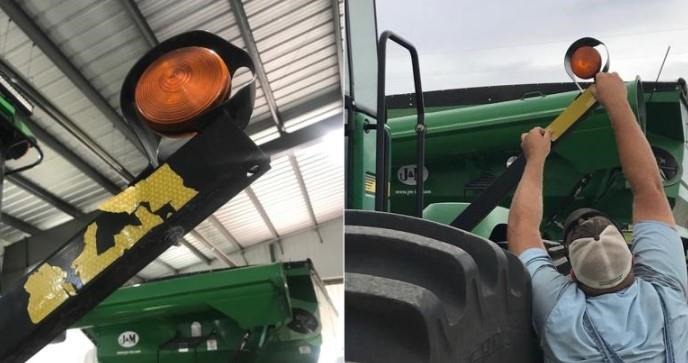Be sure to regularly wipe any dust or debris from safety reflectors, lights and mirrors on your harvest equipment both in the field and on the road. If your grain cart or wagon doesn’t come with turn signal lights, a magnetic strobe light like this one can be used to make your implement more visible from the rear in low light situations. Keep glass cleaner and paper towels or rags in your cab to clean your machine daily and prevent accidents that can occur from not seeing a car or other obstacle on the road.

Figure 1. Replace any reflectors that are not in good condition at the start of harvest season and clean reflectors and lights regularly.
2. Inspect your PTO’s safety shields for all operation
The Power Take Off (PTO) can cause severe injury without proper safety precautions. NEVER step over the PTO shaft, either while it is running or when it is not in operation. This includes a tractor and grain cart combination, combine header PTO shafts and tractors attached to an auger that might be running at a bin site. It is always better to take few extra seconds and walk around the equipment.
Inspect the guards on the PTO shaft every season. With the tractor/combine turned off and the key stored in the operator’s pocket, use one hand to spin the shield 360°. If the guard can spin without stopping or turning the power drive train, the shield is working properly. If the guard does catch or rub at any point in time, the guard should be repaired or replaced before being put back into service. Don’t forget to check the PTO shafts on the combine head as well to prevent crop from getting tangled around the shaft.
3. Look out for rocks and other debris in crop fields
Be observant as you harvest your fields and watch out for rocks or other large debris that could seriously damage your machines and slow down your harvest. If you do experience a plug in your corn head, follow this procedure to safely remove it.
- Bring the combine to a stop and back up a few feet so the head of the combine is located over harvested crop.
- Bring the combine’s threshing element to a slow speed on idle.
- Open the deck plates as wide as they will go.
- Using the reverser switch for the head, lightly bump the switch in reverse a few times to see if the plugged material becomes dislodged. If the material does not become dislodged, stop running the head. Constant running of the head can cause damage to the slip clutch, making it weak and creating excess heat.
- Follow the combine lockout procedure before ever working around or under a raised combine head. Make sure all hydraulics and shafts are removed from the combine and safety cylinder block/stops are applied.
- Using cut resistant gloves, grab a handful of material at a time and slowly begin pulling it out of the snapping rolls. Be careful; debris lodged in the snap rolls could be sharp.
4. Be aware of your crew’s location
A good practice is to honk the horn of the combine or tractor three times before starting the machine or engaging the components so other members of your crew know the machine is moving, and to give them time to move out of the way and remove themselves from moving parts.
5. Check your tow ropes and chains when extracting stuck equipment
While not every area in the state may have this problem each season, it’s important to know how to stay safe when pulling out a stuck tractor or combine. When possible, use tow ropes in good condition instead of chains. If only chains are available, inspect them to make sure both ends are in good condition and the chain itself does not have any broken, bent, or weak links. Be sure that the machine you pull with and the chain are large enough to tow the weight of the stuck machine. Never stand between a stuck vehicle and the implement towing it. Chains and ropes can break and will seriously injure anyone in their path. It’s best to stand far way and communicate with the operator of the equipment using either cell phones or two-way radios.
6. Be conscious of your mental health and seek help when necessary
There is a growing concern about mental health in the agriculture and farming community, and the harvest season can cause additional stress. Be mindful of your own mental health, as well as that of your employees, co-workers, and family. For help dealing with stress, disaster relief, and legal matters, refer to www.extension.iastate.edu/iowaconcern/ or call 1-800-447-1985.
Continue to keep up with these practices as you go through the harvest season. By using these tips and maintaining awareness of your surroundings, you can protect yourself, your investment and others on the road and in the field for a safe harvest season.
Source : iastate.edu